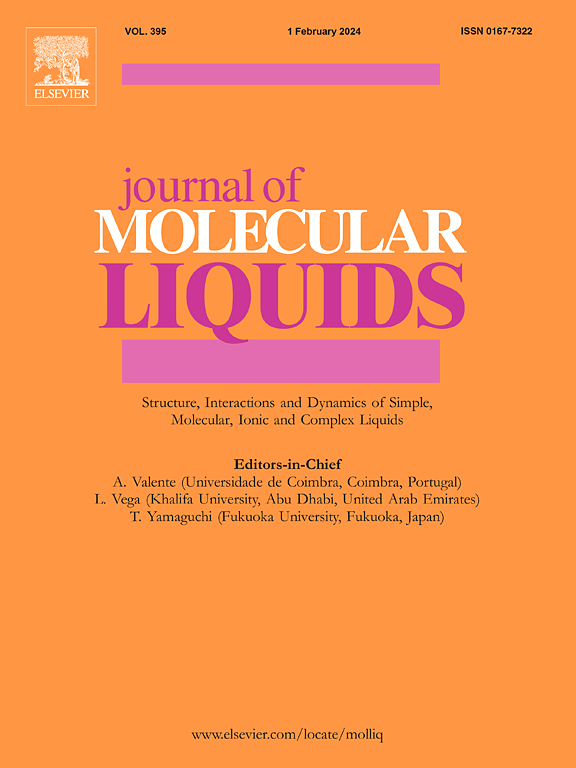通过温度相关拉曼光谱探测氟化反铁电液晶的相变研究
IF 5.2
2区 化学
Q2 CHEMISTRY, PHYSICAL
引用次数: 0
摘要
氟化液晶已成为显示技术、快速开关应用和光子设备的重要选择。在液晶中添加氟原子会改变分子内的电子分布,从而为各种显示技术引入所需的液晶特性。在本研究中,一种反铁电低聚物 (S)-octan-2-yl 2,3-二氟-4′'-((6-((2,2,3,3,4,4,5,5,6,6,6、拉曼光谱研究了 2,3-二氟-4′'-((6-((2,2,3,3,4,4,5,5,6,6,6,7-十三氟庚酰)氧基) 己基)氧基)-[1,1′,4′,1′'-三联苯]-4-羧酸盐。这种 LC 具有独特的正交反铁电排列,同时还具有手性 Smectic C (SmC*) 和 Smectic A (SmA*) 相。拉曼光谱记录的温度范围为 20 °C 至 130 °C,光谱区域为 500-3500 cm-1。此外,还利用密度泛函理论(DFT)的 B3LYP 函数和 6-31G (d, p) 基集模拟了室温下的理论拉曼光谱,结果与实验结果吻合良好。通过使用洛伦兹曲线对光谱特征进行细致的拟合,得到了所选拉曼谱带的峰位、线宽和积分强度的精确值。从分子排列和分子内/分子间相互作用的角度分析了晶体-SmCA*、SmCA*-SmC*、SmC*-SmA* 和 SmA*-各向同性相转变时拉曼光谱参数的变化。通过拉曼光谱结果,可以详细了解液晶在温度升高时发生各种相变时的分子和结构行为。本文章由计算机程序翻译,如有差异,请以英文原文为准。
Phase transition studies of a fluorinated antiferroelectric liquid crystal probed by temperature dependent Raman spectroscopy
Fluorinated liquid crystals (LCs) have emerged as a valuable option for display technologies, rapid switching applications, and photonic devices. Addition of fluorine atoms in the LCs change the electronic distribution within the molecule, introducing required LC properties for various display techniques. In this study, the structural properties of an antiferroelectric LC, (S)-octan-2-yl 2,3-difluoro-4′'-((6-((2,2,3,3,4,4,5,5,6,6,7,7,7-tridecafluoroheptanoyl)oxy) hexyl) oxy)-[1,1′,4′,1′'-terphenyl]-4-carboxylate is investigated using Raman spectroscopy. This LC exhibits a unique orthoconic antiferroelectric arrangement along with chiral smectic C (SmC*) and smectic A (SmA*) phases. Raman spectra were recorded over a temperature range of 20 °C to 130 °C, covering the spectral region of 500–3500 cm−1. Additionally, theoretical Raman spectra at room temperature is simulated using density functional theory (DFT) with the B3LYP functional and 6-31G (d, p) basis set, showing good agreement with experimental results. Through meticulous fitting of the spectral features using Lorentzian profiles, precise values for peak positions, linewidths, and integrated intensities of selected Raman bands are obtained. Changes in Raman spectral parameters at the crystalline-SmCA*, SmCA*-SmC*, SmC*-SmA*, and SmA*-isotropic phase transitions are analyzed in terms of molecular alignment and intra/intermolecular interactions. The Raman spectral results provide a detailed understanding of the molecular and structural behaviour of the liquid crystal as it undergoes various phase transitions with increasing temperature.
求助全文
通过发布文献求助,成功后即可免费获取论文全文。
去求助
来源期刊

Journal of Molecular Liquids
化学-物理:原子、分子和化学物理
CiteScore
10.30
自引率
16.70%
发文量
2597
审稿时长
78 days
期刊介绍:
The journal includes papers in the following areas:
– Simple organic liquids and mixtures
– Ionic liquids
– Surfactant solutions (including micelles and vesicles) and liquid interfaces
– Colloidal solutions and nanoparticles
– Thermotropic and lyotropic liquid crystals
– Ferrofluids
– Water, aqueous solutions and other hydrogen-bonded liquids
– Lubricants, polymer solutions and melts
– Molten metals and salts
– Phase transitions and critical phenomena in liquids and confined fluids
– Self assembly in complex liquids.– Biomolecules in solution
The emphasis is on the molecular (or microscopic) understanding of particular liquids or liquid systems, especially concerning structure, dynamics and intermolecular forces. The experimental techniques used may include:
– Conventional spectroscopy (mid-IR and far-IR, Raman, NMR, etc.)
– Non-linear optics and time resolved spectroscopy (psec, fsec, asec, ISRS, etc.)
– Light scattering (Rayleigh, Brillouin, PCS, etc.)
– Dielectric relaxation
– X-ray and neutron scattering and diffraction.
Experimental studies, computer simulations (MD or MC) and analytical theory will be considered for publication; papers just reporting experimental results that do not contribute to the understanding of the fundamentals of molecular and ionic liquids will not be accepted. Only papers of a non-routine nature and advancing the field will be considered for publication.
 求助内容:
求助内容: 应助结果提醒方式:
应助结果提醒方式:


